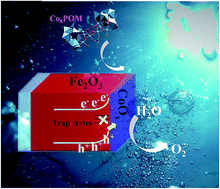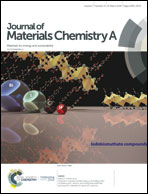Ultrathin CoOx nanolayers derived from polyoxometalate for enhanced photoelectrochemical performance of hematite photoanodes†
Abstract
Molecular oxygen evolution catalysts, particularly polyoxometalates (POMs), have been rarely reported for improving the performance of semiconductor photoanodes. Herein, a Co-based POM was investigated for modifying Fe2O3 photoanodes. The photogenerated carriers of Fe2O3 have a fundamental effect on Co8POM. Ultrathin CoOx overlayer derived from Co8POM is confirmed as the true active species, which was prepared by a simple photodeposition method. This CoOx nanolayer effectively restrains the surface states on the hematite nanorod and reduces the water oxidation overpotential. Our CoOx(POM)/Fe2O3 composite photoanode affords the best PEC performance and the highest photovoltage when compared with pristine Fe2O3 photoanode and CoOx(salt)/Fe2O3 photoanode prepared by a simple cobalt salt. The photocurrent density of CoOx(POM)/Fe2O3 photoanode is 2.2 times higher than that of pristine Fe2O3 photoanodes. Meanwhile, the CoOx(POM)/Fe2O3 composite photoanode achieves faster transient photoresponse and an improved charge injection efficiency of 80%.



 Please wait while we load your content...
Please wait while we load your content...